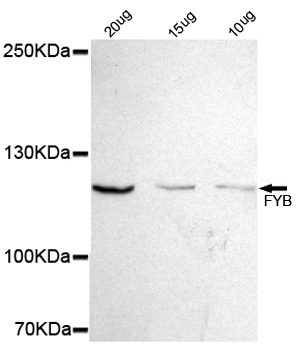FYB Antibody
Purified Mouse Monoclonal Antibody (Mab)
- SPECIFICATION
- CITATIONS
- PROTOCOLS
- BACKGROUND

Application
| WB |
|---|---|
| Primary Accession | O15117 |
| Reactivity | Human |
| Host | Mouse |
| Clonality | Monoclonal |
| Isotype | IgG1 |
| Calculated MW | 120 KDa |
| Gene ID | 2533 |
|---|---|
| Other Names | ADAP;Adhesion and degranulation promoting adaptor protein;FYB 120/130;Fyb;FYB-120/130; FYB_HUMAN;FYN binding protein;FYN T binding protein;FYN-binding protein;FYN-T-binding protein;p120/p130;PRO0823;SLAP 130;SLAP-130;SLAP130;SLP 76 associated phosphoprotein; SLP-76-associated phosphoprotein;SLP76 associated phosphoprotein. |
| Dilution | WB~~1:500 |
| Format | Liquid in PBS containing 50% glycerol, 0.5% BSA and 0.02% sodium azide, pH 7.3. |
| Storage | Store at 4°C short term. Aliquot and store at -20°C long term. Avoid freeze/thaw cycles. |
| Name | FYB1 (HGNC:4036) |
|---|---|
| Synonyms | FYB, SLAP130 |
| Function | Acts as an adapter protein of the FYN and LCP2 signaling cascades in T-cells (By similarity). May play a role in linking T-cell signaling to remodeling of the actin cytoskeleton (PubMed:10747096, PubMed:16980616). Modulates the expression of IL2 (By similarity). Involved in platelet activation (By similarity). Prevents the degradation of SKAP1 and SKAP2 (PubMed:15849195). May be involved in high affinity immunoglobulin epsilon receptor signaling in mast cells (By similarity). |
| Cellular Location | Cytoplasm. Nucleus {ECO:0000255|PROSITE-ProRule:PRU00768}. Cell junction {ECO:0000250|UniProtKB:O35601}. Note=Colocalizes with TMEM47 at cell- cell contacts in podocytes. {ECO:0000250|UniProtKB:O35601} |
| Tissue Location | Expressed in hematopoietic tissues such as myeloid and T-cells, spleen and thymus. Not expressed in B-cells, nor in non- lymphoid tissues |

Thousands of laboratories across the world have published research that depended on the performance of antibodies from Abcepta to advance their research. Check out links to articles that cite our products in major peer-reviewed journals, organized by research category.
info@abcepta.com, and receive a free "I Love Antibodies" mug.
Provided below are standard protocols that you may find useful for product applications.
Background
Acts as an adapter protein of the FYN and LCP2 signaling cascades in T-cells. Modulates the expression of interleukin-2 (IL-2). Involved in platelet activation. Prevents the degradation of SKAP1 and SKAP2. May play a role in linking T-cell signaling to remodeling of the actin cytoskeleton.
References
da Silva A.J.,et al.Proc. Natl. Acad. Sci. U.S.A. 94:7493-7498(1997).
Musci M.A.,et al.J. Biol. Chem. 272:11674-11677(1997).
Krause M.,et al.J. Cell Biol. 149:181-194(2000).
Ota T.,et al.Nat. Genet. 36:40-45(2004).
Schmutz J.,et al.Nature 431:268-274(2004).
If you have used an Abcepta product and would like to share how it has performed, please click on the "Submit Review" button and provide the requested information. Our staff will examine and post your review and contact you if needed.
If you have any additional inquiries please email technical services at tech@abcepta.com.













 Foundational characteristics of cancer include proliferation, angiogenesis, migration, evasion of apoptosis, and cellular immortality. Find key markers for these cellular processes and antibodies to detect them.
Foundational characteristics of cancer include proliferation, angiogenesis, migration, evasion of apoptosis, and cellular immortality. Find key markers for these cellular processes and antibodies to detect them. The SUMOplot™ Analysis Program predicts and scores sumoylation sites in your protein. SUMOylation is a post-translational modification involved in various cellular processes, such as nuclear-cytosolic transport, transcriptional regulation, apoptosis, protein stability, response to stress, and progression through the cell cycle.
The SUMOplot™ Analysis Program predicts and scores sumoylation sites in your protein. SUMOylation is a post-translational modification involved in various cellular processes, such as nuclear-cytosolic transport, transcriptional regulation, apoptosis, protein stability, response to stress, and progression through the cell cycle. The Autophagy Receptor Motif Plotter predicts and scores autophagy receptor binding sites in your protein. Identifying proteins connected to this pathway is critical to understanding the role of autophagy in physiological as well as pathological processes such as development, differentiation, neurodegenerative diseases, stress, infection, and cancer.
The Autophagy Receptor Motif Plotter predicts and scores autophagy receptor binding sites in your protein. Identifying proteins connected to this pathway is critical to understanding the role of autophagy in physiological as well as pathological processes such as development, differentiation, neurodegenerative diseases, stress, infection, and cancer.


